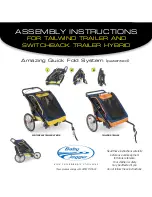
6.
Determine location for mounting junction box according to local code requirements.
Do not
mount the junction
box inside the sump or basin.
7.
Mount junction box to proper support.
8.
Run conduit to junction box. Drill proper size holes for the type of conduit used.
9.
Identify and label each wire before pulling through conduit into control panel and junction box. Make wire
splice connections at junction box.
10.
Firmly tighten all fi ttings on junction box.
11.
If a junction box is not required, pull cables through conduit into control panel.
12.
Connect pump wires per wiring diagram or schematic, and sensor or fl oat wires to the proper terminals as
shown on the schematic.
13.
Connect pump, control, and alarm incoming power conductors to proper position on terminals. See schematic
for terminal connections.
VERIFY CORRECT OPERATION OF CONTROL PANEL AFTER INSTALLATION IS COMPLETE.
Installation of C-Level Sensor and Floats
WARNING : Verify C-Level™ and IFS panel are matched with CL40 or CL100. Using wrong sensor with panel
will cause settings to be incorrect.
CAUTION:
If control switch cables are not wired and mounted in the correct order, the pump system will not function
properly. Sensor and fl oat cables need to run in separate conduit from pump and power lines.
Industry practices suggest that a secondary device, such as a fl oat switch, be used for redundant
activation of the high level alarm and pump shut off.
WARNING:
Turn off all power before installing pump wires in pump chamber. Failure to do so could result in serious
or fatal electrical shock.
NOTE:
The C-Level
™
sensor operates between 0 and 39.9 inches of water pressure for the CL40 or between 0 and
99.9 inches of water pressure for the CL100. The C-Level
™
sensor reads 0 inches at the approximate point shown in
Figure 2
. As the liquid level rises, the IFS display shows depth of liquid from the zero point. The minimum set point for
the stop (demand) or redundant off (timed dose) level is 4 inches (measured from 0) see
Figure 2
.
The maximum set point allowed is 39 inches (measured from 0) for the CL40 or 99 inches (measured from 0) for the
CL100. Operating temperature range is 32ºF (0ºC) to 120ºF (50ºC).
1.
Determine the nominal operating levels for the confi guration, as illustrated in
Figure 3 or 4.
2.
Position C-Level sensor at appropriate location on pipe and secure sensor and vent as shown in
Figure 2
using hose clamps.
WARNING:
Do not support the C-Level sensor by the cable. Position the sensor in the tank so that nothing
is pushing in the diaphragm.
3.
Position vent so it is above the water level and stow excess vent tube as shown in
Figure 2
.
WARNING:
Do
NOT
kink or place black tubing under hose clamp.
Doing so will cause sensor to fail.
4.
If optional high water or redundant off fl oats are used, position and secure as shown in
Figures 1, 3 or 4
.
Redundant off fl oat should be located to activate at approximately the zero point for the C-Level per
Figure
3 or 4
.
NOTE:
SJE-Rhombus
®
recommends using the optional high water alarm fl oat for added protection against
fl ooding.
5.
Tighten all hose clamps using a screw driver. Over tightening may result in damage to the plastic parts.
NOTE:
All hose clamp components are made of 18-8 stainless steel material. See your SJE-Rhombus
®
supplier for replacement parts.
6.
Functionally test the system by fi lling the tank and witnessing proper operation.
Installation Instructions
-2-


























